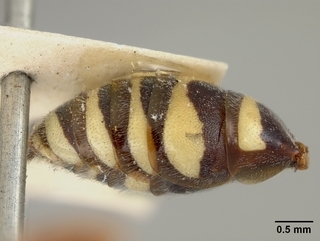
Smithsonian Institution, Entomology Department · 9
Nomada crucis, male, abdomen |
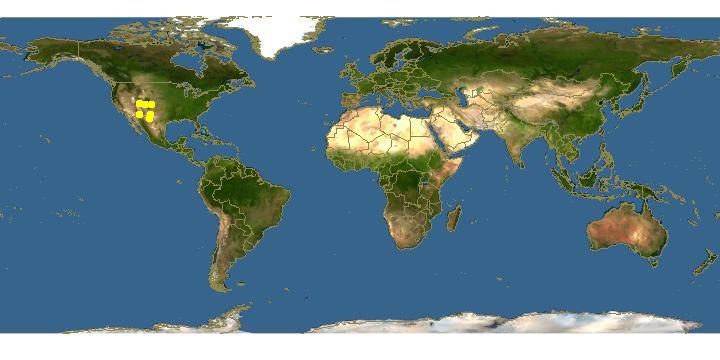
Click on map for details about points.
|
80x5 -
240x3 -
240x4 -
320x1 -
320x2 -
320x3 -
640x1 -
640x2
Set display option above.
Click on
images to enlarge. |
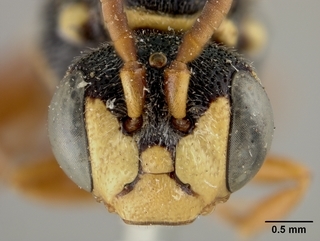
Smithsonian Institution, Entomology Department · 9
Nomada crucis, male, face |
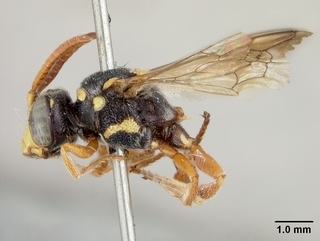
Smithsonian Institution, Entomology Department · 9
Nomada crucis, male, side |
|
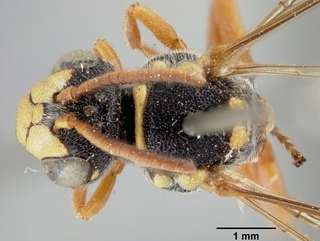
Smithsonian Institution, Entomology Department · 9
Nomada crucis, male, top |
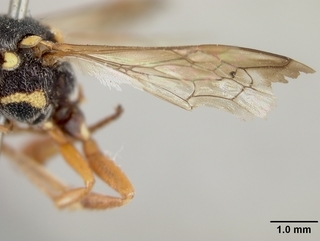
Smithsonian Institution, Entomology Department · 9
Nomada crucis, male, wing |
|
Overview |
Identification Note: There is a strong possibility that this species is the same as N. texana. The type has been seen and varies in only minor details from specimens of N. texana.
Reprinted from: Cockerell,T.A. 1903. New American hymenoptera, mostly of the genus Nomada. Ann. Mag. Nat. Hist. 64(3): 212-213
$ .�Length 7 millim.
Black, with bright yellow markings and red legs
; quite
like N. Vierecki, except in the colour of the markings, the
coarsely, densely, and confluently sculptured mesothorax,
the longer antenna?, and the strongly testaceous hind margins
of abdominal segments 2 to 5. The only red about the
thorax is on the hind part of the metathorax. Apical plate
of abdomen deeply emarginate. Also formerly confused with
N. modesta, but is smaller and without the metathoracic
spots.
Hah. Las Cruces, New Mexico, August 11 &c, 4 $
{Townsend)', Deming, N. M., at flowers of Verbesina encelioides,
July 9 (Cockerell).
This may possibly be a variety of N. neomexicana, but it
is smaller and more compact, with a shorter abdomen, the
ventral surface of which has two pale bands. By the latter
character it agrees with N. texona, to which it is extremely
similar ; but although the insect is smaller, the mesothoracic
punctures are larger (from middle line to margin near tegula?
11 or 12 in cruris, 14 or 15 in texana), and not so close on
the disk. In N. cruris the transverso-medial nervure joins the end of the externo-medial ; in texana it exactly meets the
basal.
It is proper to state that my interpretation of texana depends
upon a specimen from the collection at the Philadelphia
Academy, which to all appearances is one of the original
fourteen from which Cresson described. However, my
specimen has the venter of abdomen black, with a red spot
on first segment and conspicuous, narrowly interrupted,
yellowish- white bands on segments 3 and 4 ; whereas Cresson
says " venter varied with ferruginous, the third segment
generally with a yellow spot on each side."
|
|
|
Identification |
Extracted from Western Bees obtained by the American Museum Expeditions by Cockerell (1921).
UTAH: 19, 2d", Salt Lake City, about 5000 ft. alt., near Fort Douglas, July
28,1920, collected by Mrs. F. E. Lutz. COLORADO: 19, Grand Junction, about 4500
ft.. alt., in a vacant lot near the Fair Ground, August 3, 1920.
Described from the Mesilla Valley of 'New Mexico, and considered
a Middle Sonoran species. The specimens from Utah and Colorado are
quite typical. Swenk records it from Arizona. In Texas it intergrades
with N. texana Cresson.
Extracted from: Cockerell T.D.A., New American Hymenoptera, mostly of the Genus Nomada pp. 35-37.
MALE. —Length 7 millim.
Black, with bright yellow markings and red legs ; quite
like N. Vierecki, except in the colour of the markings, the
coarsely, densely, and confluently sculptured mesothorax,
the longer antenna?, and the strongly testaceous hind margins
of abdominal segments 2 to 5. The only red about the
thorax is on the hind part of the metathorax. Apical plate of abdomen deeply emarginate. Also formerly confused with
N. modesta, but is smaller and without the metathoracic
spots.
|
|
|
Names | |
|
|
| Supported by | |
Updated: 2024-04-29 13:04:43 gmt
|